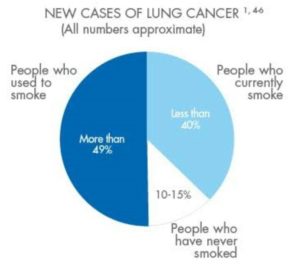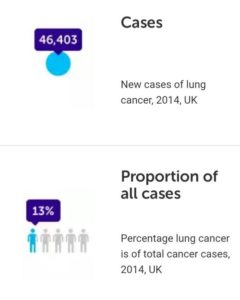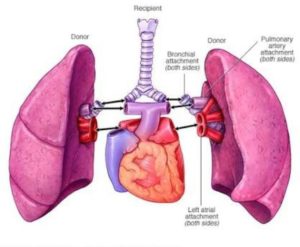Why Lung Transplant ?

Technology has emerged in all directions. And conquering the probability of early death because of perilous diseases.
Lung diseases are considered as life killer diseases, if not cured on time. And that includes
Lung Cancer :
One of the common cancer is Lung cancer nowadays. It has now become an alarming cause of death all over the world.
Causes of lung cancer:

- Smoking is the principal risk factor.
- Air pollution
- Passive smoking also can cause lung cancer.
The two types of lung cancer are, small cell lung cancer (SCLC) and non-small cell lung cancer (NSCLC).
Symptoms of lung cancer:-
- Pain in the chest or rib
- Coughing, which can be chronic, dry, with phlegm, or with blood
- Shortness of breath
- Wheezing
- Weight loss
Scenario of lung cancer and the need of lung transplant

As pointed out previously, lung cancer is biting the lives of a large number of people all over the world.
Around 13 percent of all new cancer cases are of lung cancer and 19 percent of cancer related deaths are because of lung cancer. There were 1.8 million new lung cancer cases estimated to occur in 2012. In India, lung cancer constitutes 6.9 per cent of all new cancer cases and 9.3 per cent of all cancer related deaths in both sexes, Lung cancer is the most common cancer related death cause in men.
(Status information from- https://www.ncbi.nlm.nih.gov/pmc/articles/PMC4405940/)
Here is also an image showing scenario of lung cancer in UK.
(Credit: Cancer Research UK)
So, considering these surveys, it’s clear, that healing lung cancer is important. When it gets worse, lung transplant becomes the necessity. Let’s see how do doctors make the patients live peacefully again.
Procedures of lung cancer:
- The very first thing the surgeon starts with is anesthesia. So, the patient will not feel any pain. The patient does not have to worry about tragic and panic moments.
- The next step is then, cutting through the patient’s chest and removing his/her lung, which is in the worst condition because of lung cancer. The main airway to that lung and the blood vessels between that lung and heart will then be connected to the donor lung. For some lung transplants, the patient may be connected to a heart-lung bypass machine, which circulates the blood during the procedure.

- Once, after the surgery is over, the patient is supposed to be in the ICU for days. The tubes in a patient’s chest will drain fluids from around lungs and heart. A tube in a vein will deliver strong medications to control pain and to prevent rejection of the new lung.
- As the patient’s health condition improves, he / she is permitted to move out of the ICU.
- And then the recovery stage starts. Basically, it includes two to three weeks of hospital stay. The end is really far though. After these weeks, patients gets the leave from the hospital. After that, three months of constant and regular monitoring is needed by the lung transplant The reason behind this monitoring is, to prevent, detect or treat complications of lung function. Gradually, it becomes less frequent visits.
- One may wonder what does a follow up visit involve? Here is the answer! It may involve chest X-rays, lung function tests, laboratory tests, an electrocardiogram (ECG), a lung biopsy and checkups with a specialist etc.
- Doctors remove very small lung tissue samples to test for signs of rejection and infection. And this test is conducted during Bronchoscopy.
Let’s shed more light on
A doctor inserts a small, flexible tube through the mouth or nose into the lungs. A small camera attached to the bronchoscope allows the doctor to look inside the lungs’ airways.
The transplant team then monitors closely and help to manage medications’ side effects. The team may also monitor and treat infections. Your doctor might prescribe an antibiotic, antiviral or antifungal medications to help prevent infections.
- There is a saying that never lies to your doctor. The hide games of symptoms will only lead to complications. So, it is very important to let the transplant team know if one notices any signs or symptoms of rejection.
- And, of course, there are some things to be taken care of by one for a long period, after the lung transplant surgery:-
- Immunosuppressants medications to prevent rejection of the donor lung and for a sustainable immunity system.
- A lifelong plan for managing medications and instructions from the doctor.
- Regular check ups and follow up appointments to ensure your better health and check your lung.
- Follow a proper schedule and timetable directed as per the doctor.
Improvement and discipline are always acceptable…
The tougher part comes after the surgery. As maintaining your body and health to prevent further difficulties is never easy. Setting up a new routine is hectic for sure, but it may get smoother if one tries. After all, it’s not an impossible thing to follow.
The wisest advice is not to skip your medication anyhow. It’s a good thing to follow a timetable and to make a list of medicines, in order to not to forget.
Mark a particular time, so that it may become easier to remember. Make a habit of carrying important medications with you, so that if you are out for some, still you can follow up with your routine.
Say a strict no to tobacco and alcohol products. It’s better to have a proper diet plan. A balanced chart of nutritions will always help one to stay healthy. And say, who does not want a healthy life?
The irreplaceable part of staying healthy and normal even after the surgery is exercise only. Your lung transplant team may help you to make a routine of work out for you. Your doctor may recommend pulmonary rehabilitation.
Going through a totally new phase of life may result in stress and frustration. In that case, one should never let the second thought rule over one’s mind and should contact the doctor.
An emotional support is a brick that holds your will and struggles together. It’s a trauma if you see from a patient’s eyes. Gathering all the courage to fight alone is a myth. There is always a need of emotional support. So, support them. They are not weak, make them feel so. In fact, they are living a new life all with a new start.
And last, but the most important, be a donor. There is no such big thing than donating you are any body part. It may not give you instant claps, but when a life is saved, definitely no earnings can be greater than this. Be someone’s savior, it doesn’t matter if it’s indirect.
A YouTube video of a patient’s lung transplant story is shared here to wake your nerves up and make you realize the physical and mental procedure and conditions.
Video link:-
